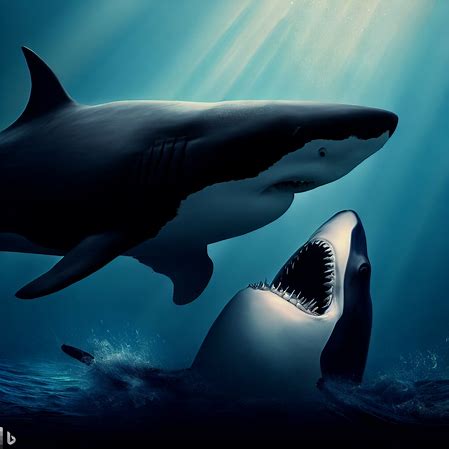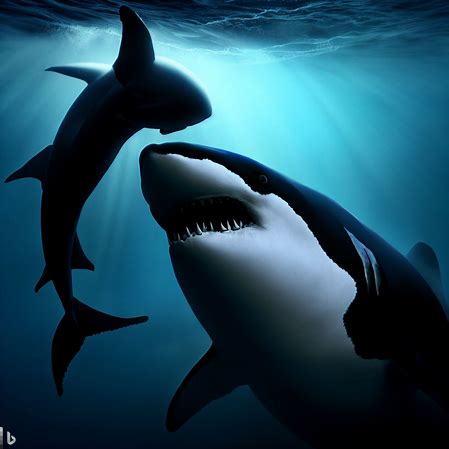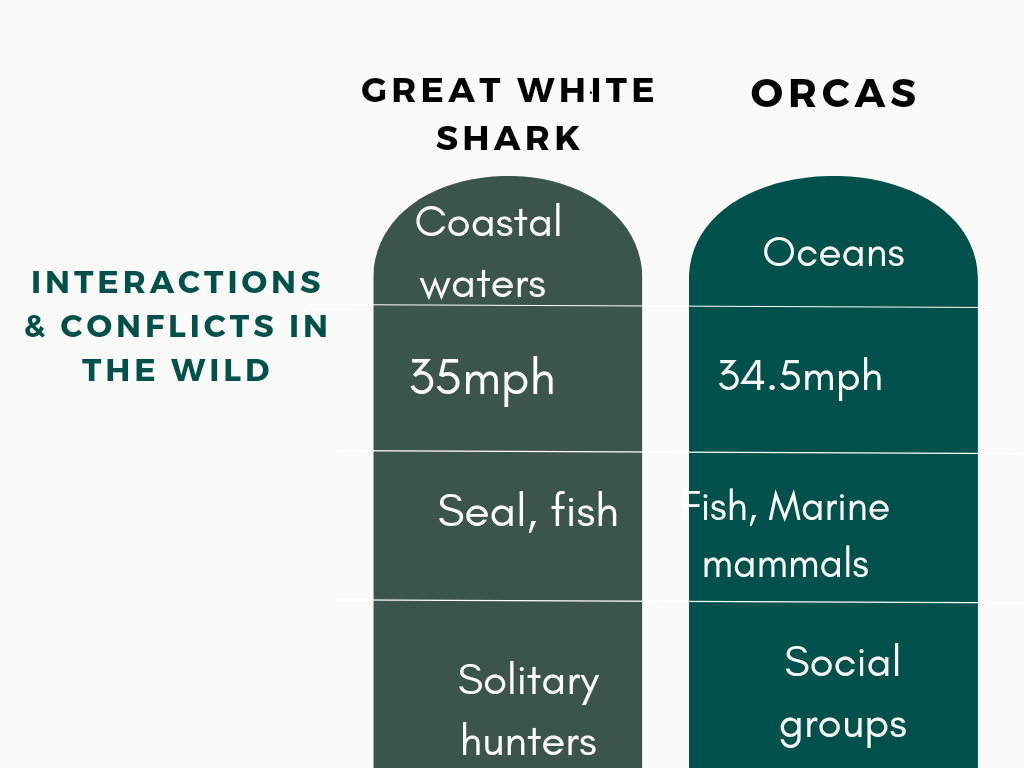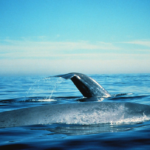
Key Takeaways
- The great white shark and the orca, also known as the killer whale, are two of the most powerful predators in the ocean.
- While both species are apex predators, they have different hunting strategies and prey preferences.
- Great white sharks primarily feed on seals, sea lions, and smaller fish, using their speed and stealth to ambush their prey.
- Orcas, on the other hand, are highly intelligent and social animals that hunt in groups called pods. They have a diverse diet that includes fish, seals, sea lions, and even other whales.
- When it comes to a direct confrontation between a great white shark and an orca, the orca usually comes out on top. Orcas have been observed flipping great white sharks upside down, rendering them immobile and vulnerable.
- The reason behind the orca’s dominance over the great white shark is likely due to their intelligence, teamwork, and ability to adapt their hunting strategies.
- Despite their differences, both great white sharks and orcas play crucial roles in maintaining the balance of marine ecosystems.
- Understanding the dynamics between these two apex predators can help researchers and conservationists develop strategies to protect and preserve their populations.
The ocean is home to two of nature’s most intimidating apex predators – the Great White Shark and the Orca, aka the killer whale. Both of them have mesmerized us for centuries and embody power, elegance, and unbridled ferocity.
The Great White Shark is equipped with a streamlined body, allowing it to move quickly through the sea, and sharp teeth that can crush bones. But Orcas are equally formidable, as they are smart and use strategic hunting patterns. Hunting in packs, each member plays an important part in securing their next meal.
The two predators differ in their hunting techniques and diets. Great Whites usually go after marine mammals like seals and sea lions, using stealth and speed to surprise their prey. Meanwhile, Orcas have a wide range of hunting methods – from beaching to create waves that knock seals off ice floes, to complex tactics for hunting dolphins.
Not only are these apex predators fascinating to observe, but they also play an essential role in preserving a balanced ecosystem in the sea. They help maintain marine biodiversity by reducing weak or diseased individuals from prey populations.
Let’s appreciate their beauty and remember our responsibility to protect them and their habitats for future generations. Delve into the amazing world of the Great White Shark versus the Orca and explore the breathtaking encounters, astonishing discoveries, and mysterious mysteries in their thrilling clash!
Overview of the Great White Shark
The Great White Shark is a fascinating creature, renowned for its immense size and power. It has a sleek body and sharp teeth, making it one of the ocean’s most formidable hunters. On average, these sharks measure 15 feet (4.6 meters) in length and weigh 2,500 to 3,000 pounds (1,100 to 1,400 kg). They can live up to 70 years and eat predominantly carnivorous prey. They can be found in temperate and tropical waters worldwide, both in coastal waters and open oceans.
Not only are these sharks physically impressive, they also possess a highly developed sense of smell. This allows them to detect minute traces of blood in the water, making them incredibly efficient hunters. Plus, they can move with impressive speed and agility through their marine habitats.
In 2000, a group of divers encountered a curious Great White Shark while exploring an underwater cave system. The shark cautiously approached the divers, but eventually became aggressive. Despite their best efforts, it attacked one of them. Fortunately, the diving team escaped unscathed due to their training and quick thinking.
The Great White Shark remains a mysterious creature of the deep. Its presence is both awe-inspiring and humbling, reminding us of the power and beauty that exists beneath the surface. As scientists continue to uncover more about these magnificent creatures, we gain a greater appreciation for their role in maintaining the delicate balance of our marine ecosystems.
Overview of the Orca
The Orca, also known as the killer whale, is a highly intelligent and social marine mammal. It stands apart from other species with its unique characteristics. Let’s take a look at the Orca!
Scientific Name: Orcinus orca
Family: Delphinidae
Size: Up to 32 feet (9.8 meters) long and can weigh up to 22,000 pounds (10,000 kilograms).
Diet: Varies by population but includes fish, seals, sea lions, penguins, and even other whales.
Habitat: Oceans all over the world, from the Arctic to the Antarctic regions.
This recognizable creature has a black and white coloration and a robust body with a sleek shape, enabling fast swimming speeds. Its sharp teeth and powerful jaws make hunting and devouring large prey easy.
Orcas have complex social structures in their pods and strong familial ties. They communicate with each other using a variety of vocalizations like clicks, whistles, and calls, each pod having its own dialect.
Coordinated hunting strategies displayed by orcas are incredible. They use techniques such as wave washing to dislodge seals from ice floes and create waves that wash them ashore for an easy catch. This demonstrates their advanced problem-solving skills and adaptability in the wild.
In the great white shark vs orca battle, it’s clear that these creatures are so much more than just sharp teeth!
Physical Characteristics and Adaptations

The physical traits of these two animals make them formidable foes. Great white sharks feature a streamlined body, perfect for cutting through water quickly and razor-sharp teeth that tear flesh efficiently. Orcas boast a sleek design for gliding through the ocean and powerful jaws with sharp teeth for catching prey.
Great white sharks are able to detect even the faintest scent of blood in the water from miles away with their acute sense of smell. Orcas, on the other hand, possess superior intelligence with complex social behaviors and effective hunting strategies.
Recently, a brave encounter between a great white shark and an orca pod was witnessed off the coast of South Africa. This rare event reminded researchers of the power struggle between these two species, and of their strength and adaptability.
It’s time to see who will be crowned top predator – great white sharks or orcas – in the ultimate seafood buffet showdown!
Hunting and Feeding Behaviors
Great white sharks and orcas have remarkable hunting and feeding habits. Let’s learn more about them!
To understand their behaviors, here is a table that covers key points of both:
| Great White Shark | Orca | |
|---|---|---|
| Diet | Fish, seals, sea lions, small sharks | Fish, squid, marine mammals, seals, dolphins |
| Hunting Strategy | Ambush attack from below | Intelligent cooperation strategies in pods |
| Hunting Techniques | Stealthy approach | Cooperative hunting methods like wave wash |
| Feeding Patterns | Feeding frenzies | Rips apart prey with strong jaws |
A unique detail about these creatures’ hunting and feeding habits is that great whites breach out of the water while attacking. This sets them apart from other predators.
Some orcas have developed techniques to hunt specific prey species. Certain Antarctic populations use icy shores to catch young seals. This shows their intelligence and resourcefulness.
Fact: Great white sharks have an incredible sense of smell that can detect a drop of blood miles away. (source: National Geographic)
By studying these apex predators, we gain insight into their role in the marine ecosystem.
Habitat and Distribution: Great whites and orcas love to travel, but don’t have matching passports!
Habitat and Distribution
Great whites and orcas have different habitats and distributions. Great whites are usually found near continental shelves, with cooler waters. Whilst orcas can be found in all major oceans, from polar to tropical!
Uniquely, great whites hunt in deep waters, whereas orcas are happy in shallow coastal regions and deep ocean trenches.
In 1977, something remarkable happened. An orca flipped a great white upside down, causing it to become immobile – demonstrating their strength and intelligence.
Social Structure and Behavior
Sharks and orcas both have complex social structures and behaviors. These creatures show intelligence, cooperation and communication in their groups.
Leadership: Both have dominant individuals that take charge and lead the way.
Hunting Techniques: They employ similar strategies – great whites use surprise, orcas create waves to knock off seals.
Communication: They both use body language, postures and chemical signals, and orcas use vocalizations and echo-location too.
Migratory Patterns: Both species travel for food and to find mating grounds.
Unique Behaviors: Sharks breach the surface for prey, orcas have cultural traditions.
Temperature Control: Scientists have confirmed great whites can regulate their temperature.
Threats and Conservation Status: Not easy to pick between these two – both have sharp teeth and deadly jaws!
Threats and Conservation Status
Great white sharks and orcas face many threats in their natural habitats. This can have huge effects on their conservation status. Knowing these risks is vital for creating effective strategies for conservation.
Threats:
- Great White Shark: Overfishing – Vulnerable. Habitat Loss – -. Pollution – Susceptible to toxins. Climate Change – Vulnerable.
- Orca: Overfishing – Endangered. Pollution – Impacted by oil spills. Climate Change – Population decline due to changing food availability.
Furthermore, the public perceive great white sharks as aggressive predators. People ignore their role in keeping marine ecosystems steady.
Orcas also face unique tests due to captivity. Keeping these clever creatures for entertainment has stirred ethical issues and debates about stricter regulations.
The International Union for Conservation of Nature (IUCN) lists great white sharks and orcas as vulnerable or endangered species. This highlights the necessity for increased conservation efforts to protect these amazing creatures and maintain balance in marine ecosystems.
Interactions and Conflict in the Wild

Interaction and conflict between great whites and orcas in the wild? Fascinating! Let’s dive in and uncover some wild facts.
The predators show off their remarkable hunting skills, competing for resources. We’ll examine a snapshot of data:
| Great White Sharks | Orcas | |
|---|---|---|
| Habitat | Coastal waters | Ocean |
| Speed | 35 mph | 34.5 mph |
| Diet | Seals, fish | Fish, marine mammals |
| Behavior | Solitary hunters | Social groups |
We see distinct characteristics of each species, like habitat, speed, diet, and behavior.
Orcas are smart and work together during hunts. This gives them an advantage over solitary great whites. They can tackle large prey with ease.
Pro Tip: Don’t forget! Both great whites and orcas play important roles in marine ecosystems. The battle they fight is captivating – popcorn included!
Frequently Asked Questions
Q: Can a great white shark defeat an orca?
A: While great white sharks are formidable predators, an adult orca has the advantage in a direct confrontation. Orcas are highly intelligent, larger, and have a complex hunting strategy that enables them to overpower great white sharks.
Q: Do orcas eat great white sharks?
A: Yes, orcas are known to prey on great white sharks. They target the liver, which is rich in energy-rich fats. However, it is not a common occurrence and there is no evidence to suggest that orcas actively seek out great white sharks as a primary food source.
Q: Are great white sharks scared of orcas?
A: Great white sharks may show signs of fear or caution when encountering orcas. Orcas possess a unique ability to induce tonic immobility in sharks, which essentially paralyzes them temporarily. This behavior indicates that great white sharks perceive orcas as a potential threat.
Q: Can orcas kill a great white shark with their tails?
A: Orcas are known to use their powerful tails to deliver powerful blows to incapacitate their prey. While it’s possible for an orca to strike a great white shark with its tail, it is more common for orcas to rely on suffocation or drowning techniques during hunting.
Q: Do great white sharks and orcas compete for the same food?
A: Great white sharks and orcas do overlap in terms of their prey preferences, particularly in areas where both species coexist. However, their hunting strategies and preferred prey species often differ, minimizing direct competition between the two.
Q: Are great white sharks or orcas more dangerous to humans?
A: In terms of recorded incidents, great white sharks are responsible for more attacks on humans than orcas. However, both species are considered apex predators and should be approached with caution and respect in their natural habitats.
Conclusion
It’s clear that the great white shark and the orca are both strong predators. They have different traits and strategies for hunting. The great white shark is fast and can bite hard. The orca is smart and can hunt many marine animals, like fish and seals.
The great white shark mainly eats seals and other mammals. Orcas have a wider diet, which can include squid and other mammals. This gives orcas an upper hand when looking for food.
The two predators also differ in their social behavior. Orcas live in pods and communicate using special sounds. This lets them hunt together, which makes them more successful than the great white shark.
Sadly, these animals are threatened by humans. Pollution, overfishing, and destruction of habitats are all a risk. Conservation efforts are necessary to help them survive.
Remember: When you see a great white shark or an orca in the wild, stay far away! They should be admired and protected.
References
https://www.sciencefocus.com/science/head-to-head-orca-vs-great-white-shark/
https://a-z-animals.com/blog/epic-battles-the-largest-great-white-ever-vs-a-killer-whale/




